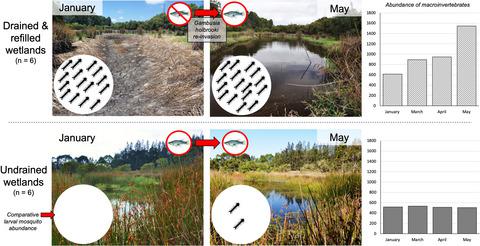当前位置:
X-MOL 学术
›
J. Appl. Ecol.
›
论文详情
Our official English website, www.x-mol.net, welcomes your feedback! (Note: you will need to create a separate account there.)
Management of urban wetlands for conservation can reduce aquatic biodiversity and increase mosquito risk
Journal of Applied Ecology ( IF 5.7 ) Pub Date : 2020-03-02 , DOI: 10.1111/1365-2664.13576 Jayne K. Hanford 1, 2 , Cameron E. Webb 2, 3 , Dieter F. Hochuli 1
中文翻译:

管理城市湿地以进行保护可减少水生生物多样性并增加蚊虫风险
更新日期:2020-03-02
Journal of Applied Ecology ( IF 5.7 ) Pub Date : 2020-03-02 , DOI: 10.1111/1365-2664.13576 Jayne K. Hanford 1, 2 , Cameron E. Webb 2, 3 , Dieter F. Hochuli 1
Affiliation

|
- Global wetland loss means constructed urban wetlands are an increasingly valuable resource for conservation. However, priorities for managing urban wetlands for conservation are often seen to conflict with management to reduce potential mosquito risks, such as nuisance biting and pathogen transmission. Understanding the ecological consequences of wetland management practices is vital to maximize the conservation value of urban wetlands without negatively impacting public health; however, management practices are often untested.
- We conducted a landscape‐scale experiment to test the ecological impacts of an existing urban wetland management regime, in which a group of urban wetlands are drained annually to reduce the abundance of an invasive fish, the plague minnow Gambusia holbrooki, and then refilled to provide breeding habitat for a threatened frog, the green and golden bell frog Litoria aurea. We collected and compared aquatic macroinvertebrates and mosquito larvae from these refilled wetlands, and adjacent undrained wetlands, as well as sampling adult mosquito populations on four occasions across summer and autumn.
- Wetland draining had a significant effect on aquatic macroinvertebrates and larval mosquitoes. Twice as many macroinvertebrates were collected from drained wetlands compared to undrained wetlands, and almost all mosquito larvae were collected from drained wetlands. Differences in macroinvertebrate assemblages and larval mosquitoes at drained and undrained wetlands decreased over time, but total macroinvertebrate abundance and taxa richness did not.
- Synthesis and applications. While conserving threatened habitats and species is vitally important, our results highlight how wetland management practices can unintentionally impact non‐target species, and potentially public health. As constructed urban wetlands become more common, so too does the need for routine maintenance and management of threatened and invasive species. It is essential that future design and management of urban wetlands considers the impact mosquitoes might have on humans. Pre‐emptive action to control geographically relevant vectors of mosquito‐borne pathogens and nuisance biting species would reduce human exposure to mosquitoes and associated negative impacts, and increase positive conservation outcomes associated with urban wetlands.
中文翻译:

管理城市湿地以进行保护可减少水生生物多样性并增加蚊虫风险
- 全球湿地的丧失意味着人工建造的城市湿地已成为越来越有价值的保护资源。但是,通常认为管理城市湿地进行保护的优先顺序与减少潜在蚊虫风险(例如讨厌的咬和病原体传播)的管理相冲突。了解湿地管理实践的生态后果对于最大化城市湿地的保护价值而不会对公共健康造成负面影响至关重要;但是,管理实践通常未经测试。
- 我们进行了景观规模的试验,以测试现有城市湿地管理制度的生态影响,每年对一组城市湿地进行排水,以减少入侵性鱼类-鼠疫小鱼Gambusia holbrooki的数量,然后重新填充以提供绿色和金色铃铛青蛙Litoria aurea的繁殖栖息地。我们收集并比较了这些重新填充的湿地和邻近的不排水湿地的水生无脊椎动物和蚊虫幼虫,并在夏季和秋季分别进行了四次采样,以采集成年蚊虫种群。
- 湿地排水对水生无脊椎动物和幼体蚊子有显着影响。与不排水的湿地相比,从排水的湿地收集的大型无脊椎动物是其两倍,几乎所有的蚊虫幼虫都是从排水的湿地收集的。排水和不排水湿地大型无脊椎动物组合和幼虫的差异随着时间的推移而减小,但大型无脊椎动物的总丰度和分类单元的丰富度却没有。
- 综合与应用。尽管保护濒临灭绝的栖息地和物种至关重要,但我们的研究结果强调了湿地管理实践如何无意间影响非目标物种和潜在的公共卫生。随着人工湿地变得越来越普遍,对威胁和入侵物种的日常维护和管理的需求也越来越普遍。未来的城市湿地设计和管理必须考虑到蚊子对人类的影响,这一点至关重要。采取先发制人的行动来控制与地理有关的蚊媒病原体和令人讨厌的咬伤物种,将减少人类接触蚊子的风险和相关的负面影响,并增加与城市湿地有关的积极保护成果。



























 京公网安备 11010802027423号
京公网安备 11010802027423号